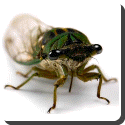 Cicada — A Cicada is an insect of the order Hemiptera, suborder Auchenorrhyncha, in the superfamily Cicadoidea, with large eyes wide apart on the head and usually transparent, well-veined wings. There are about 2,500 species of cicada around the globe, and many remain unclassified. Cicadas live in temperate to tropical climates where they are among the most widely recognized of all insects, mainly due to their large size and remarkable acoustic talents. Cicadas are sometimes colloquially called “locusts”, although they are unrelated to true locusts, which are a kind of grasshopper. They are also known as “jar flies”. Cicadas are related to leafhoppers and spittlebugs. In parts of the southern Appalachian Mountains in the United States they are known as “dry flies” because of the dry shell they leave behind.
Cicada — A Cicada is an insect of the order Hemiptera, suborder Auchenorrhyncha, in the superfamily Cicadoidea, with large eyes wide apart on the head and usually transparent, well-veined wings. There are about 2,500 species of cicada around the globe, and many remain unclassified. Cicadas live in temperate to tropical climates where they are among the most widely recognized of all insects, mainly due to their large size and remarkable acoustic talents. Cicadas are sometimes colloquially called “locusts”, although they are unrelated to true locusts, which are a kind of grasshopper. They are also known as “jar flies”. Cicadas are related to leafhoppers and spittlebugs. In parts of the southern Appalachian Mountains in the United States they are known as “dry flies” because of the dry shell they leave behind.
Cicadas do not bite or sting, are benign to humans, and are not considered a pest. Many people around the world regularly eat cicadas: the female is prized as it is meatier. Cicadas have been (or are still) eaten in Ancient Greece, China, Malaysia, Burma, Australia, Latin America and the Congo. Cicadas are employed in the traditional medicines of China.
Cicadas are arranged into two families: Tettigarctidae (q.v.) and Cicadidae. There are two extant species of Tettigarctidae, one in southern Australia, and the other in Tasmania. The family Cicadidae is subdivided into the subfamilies Tettigadinae, Cicadinae and Cicadettinae, and they occur on all continents except Antarctica.
he adult insect, sometimes called an imago, is usually 2 to 5 cm (1 to 2 inches) long, although some tropical species can reach 15 cm (6”), e.g. Pomponia imperatoria from Malaysia. Cicadas have prominent eyes set wide apart on the sides of the head, short antennae protruding between or in front of the eyes, and membranous front wings. Desert cicadas are also among the few insects known to cool themselves by sweating, while many other cicadas can voluntarily raise their body temperatures as much as 22 °C above ambient temperature.
Male cicadas have loud noisemakers called “timbals” on the sides of the abdominal base. Their “singing” is not the stridulation (where two structures are rubbed against one another) of many other familiar sound-producing insects like crickets: the timbals are regions of the exoskeleton that are modified to form a complex membrane with thin, membranous portions and thickened “ribs”. Contracting the internal timbal muscles yields a pulse of sound as the timbals buckle inwards. As these muscles relax, the timbals return to their original position. The interior of the male abdomen is substantially hollow to amplify the resonance of the sound. A cicada rapidly vibrates these membranes, and enlarged chambers derived from the tracheae make its body serve as a resonance chamber, greatly amplifying the sound. They modulate their noise by wiggling their abdomens toward and away from the tree that they are on. Additionally, each species has its own distinctive song.
 Kids Portal For Parents India Kids Network
Kids Portal For Parents India Kids Network
